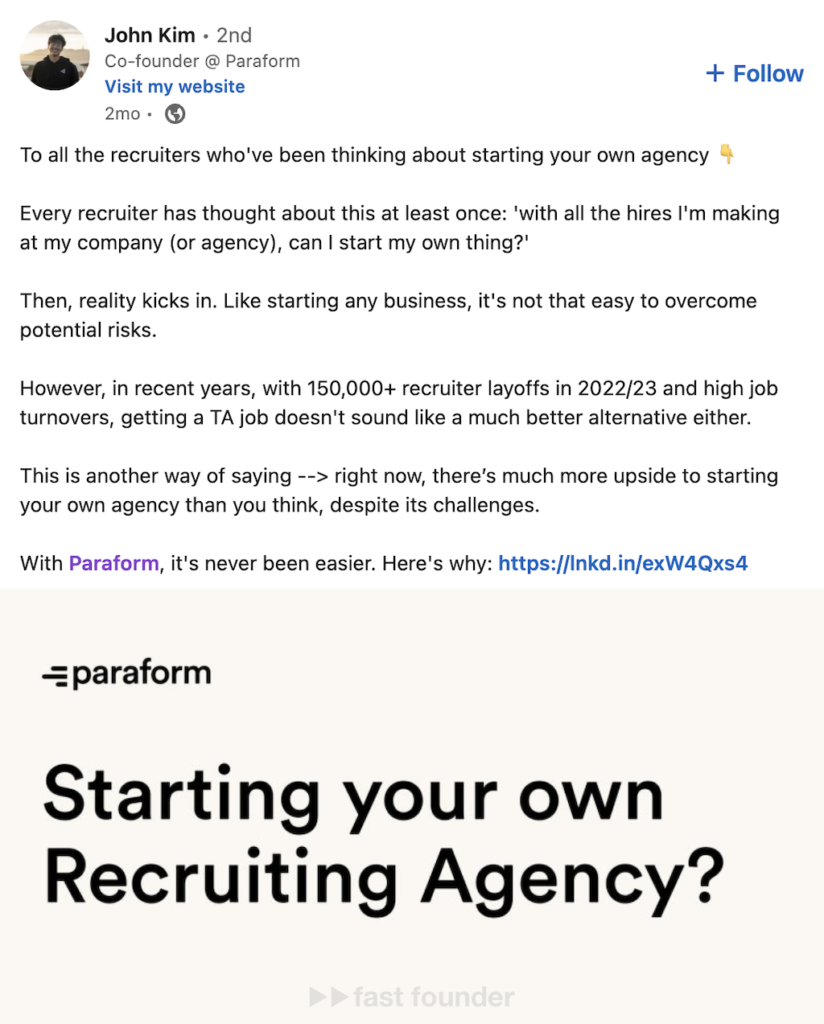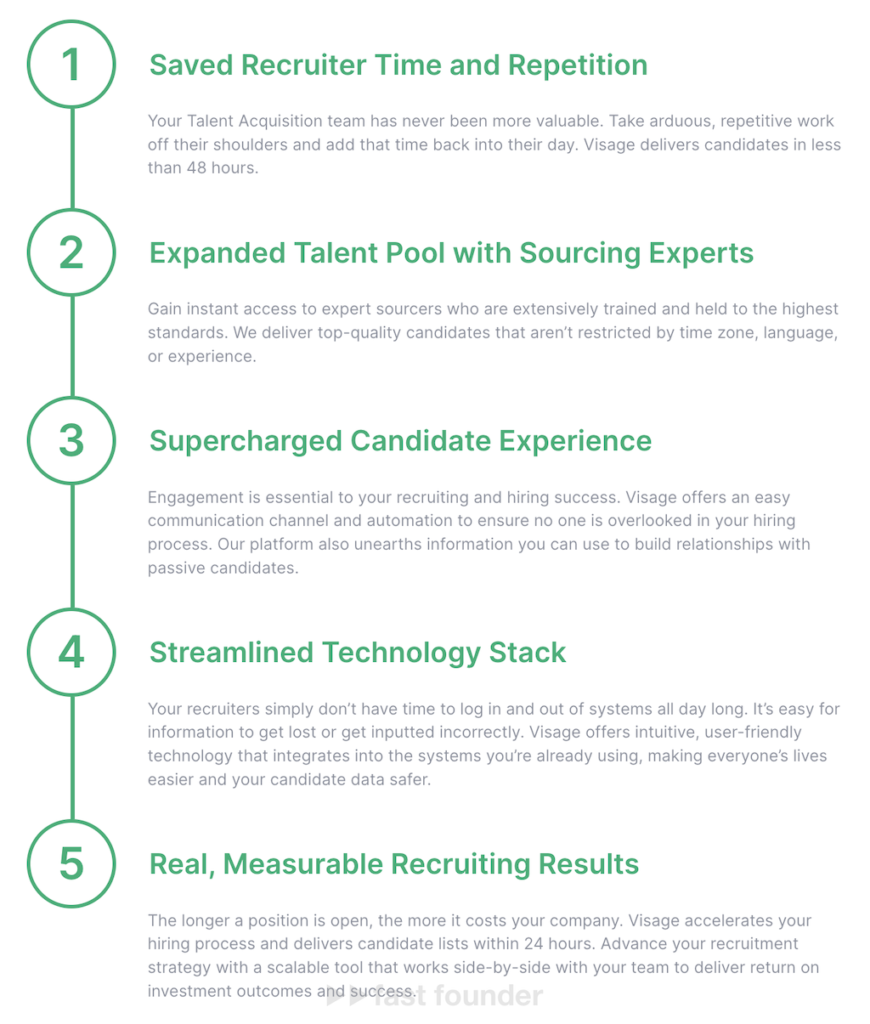- Classic marketplaces connect buyers with sellers or clients with service providers directly. However, in a number of cases, “directly” is difficult or inefficient, or simply doesn’t work 😉 For example, how do you find a good candidate for a skilled position?
- Such individuals usually do not actively seek employment, so they hardly visit regular job vacancy websites. The only way to reach them is through recruiters who have direct connections with them. But how do you reach these recruiters? 😉
- It turns out that to fill skilled positions, you need not a job vacancy website or resume database, but a marketplace of recruiters. This leads us to a new concept altogether—a “mediator marketplace”! Which can be applied in other in-demand areas as well:
Project Essence

Paraform is a website through which companies search for employees.
Its feature is that it is designed to find employees for positions that are difficult to fill in the usual way. The “uniqueness of the image” of Paraform is that on their website, companies communicate not with potential candidates, but with recruiters who, in turn, are engaged in finding the right candidates for the company.

The target audience of companies looking for employees in this way includes early and late-stage startups, research companies, developers, and manufacturers of gadgets and equipment.

The startup is currently focused on recruiting programmers, marketers, scientists, and researchers, but in the near future, it plans to expand the range of positions.

Companies post vacancies on the website, and recruiters choose positions that they can fill using their existing databases of potential candidates. Each position immediately specifies the reward that the recruiter will receive for filling it—thus, the recruiter can choose work based on opportunities and budget.

The startup claims that the platform allows recruiters to earn more than if they were working as recruiters in a company or in a recruitment agency. According to the startup’s calculations, working 10 hours a week, in a company, a recruiter can earn $1.4 thousand, in a recruitment agency — $6 thousand, and on the platform — $15 thousand or more.

At the same time, hiring through the platform costs companies an average of 40% less than hiring through their own recruiters or through a recruitment agency. Moreover, hiring in this way happens three times faster. This is partly because more qualified candidates come to companies through the platform, 70% of whom at least reach the stage of personal interviews.

The startup already has more than 200 companies as clients, with a satisfaction rate of 98% with the platform’s services.

The startup was founded last year, and now it is growing well—its revenue compared to last year has increased by 10 times. At the same time, there are only four people working in the startup itself.
At the end of March last year, Paraform attracted its first $1.4 million in pre-seed investments, and now — new $3.6 million.
What’s Interesting
What Has Changed? Why did today’s Paraform decide to implement the model of hiring within companies through a marketplace of external recruiters?

The founder of Paraform says that due to the deteriorating financial situation in the market in 2022–2023, more than 150 thousand recruiters were laid off from companies—left “on the street” with their qualifications and databases of potential clients.
Of course, they can try to find work in another company. But a much more interesting option is to finally open their own recruitment agency. Especially since many of them have already thought about “creating something of their own.”
But the first question in this case is where to get recruitment orders from, to start earning “keeping their pants up” and further development? Paraform offers such newly-minted agencies to connect to their platform and immediately start receiving orders, earning decent rewards.
Thus, once again, we encounter the fact that the rise of any business model relies on the timeliness of its appearance in the market.
The dismissal of a large number of recruiters is an opportunity for the startup to gain a large number of candidate suppliers through its marketplace, which in turn will arouse companies’ interest in the marketplace, which in turn will begin to attract new recruiters to work through the marketplace, which in turn will increase the number of companies willing to receive candidates through the marketplace—and so on in an expanding and growing spiral.

By the same model, another startup, Jomigo, started working, about which I wrote in the fall of 2022. At that time, it raised 10 million euros in the very first round of investments.

The startup HirePort, about which I wrote in early 2023, literally started working on the same model and raised $1.6 million in investments for this. However, now it has begun to develop more towards technology. Its current product is a platform for managing the candidate pipeline coming into the company from various sources. Including from external recruiters, whom the startup still attracts to search for candidates for companies.

The startup Visage, about which I wrote in the spring of 2021, is creating a comprehensive platform for automating the work of company recruiters, which uses AI technologies. However, a significant part of the platform is also “crowdsourcing” of candidates—when external recruiters can take orders from the platform to supply candidates for companies. These candidates are initially evaluated using AI, and the most suitable of them are passed on to live company recruiters. This startup raised $10.9 million in investments.
Thus, a marketplace of external recruiters can become a starting point for a startup to enter the market—after which it can proceed to expand its activities by creating more complex technological solutions.
Where to Run
The first obvious direction for potential movement is to go in the same direction of creating a marketplace that connects companies with recruiters instead of traditional job sites, which connect companies directly with potential candidates.
Such marketplaces can be a more effective tool for companies—but only if it concerns truly hard-to-fill positions. The trick is that the best candidates in this case are “passive” candidates who are not actively seeking work themselves and therefore hardly visit ordinary job sites.
Reaching out to them can only be done through recruiters who can directly approach such candidates. But even these recruiters need to be reached somehow 😉 And this is exactly what marketplaces similar to the ones mentioned today allow.
The shortage of qualified personnel in the labor market exists and will not disappear anytime soon, and it may even worsen. So, this direction is quite long-term. However, it is worth remembering that such a marketplace can only become an entry point for creating a more complex technological service similar to some of today’s startups.
The second option is to think about where else a similar “intermediary marketplace” model can be implemented. After all, in this model, a recruiter is an intermediary who connects companies with candidates that he finds himself.
Classic marketplaces connect sellers directly with buyers and clients with contractors. However, in many cases, it is difficult for a client or buyer to find a suitable contractor or seller—starting from “anyone suitable” and ending with “suitable in terms of quality or deadlines.”
To solve this problem, so-called “managed marketplaces” began to appear. Such marketplaces themselves act as “intermediaries”—finding suitable contractors and controlling the quality of the services provided.
However, in such a model, the marketplace itself can become a “bottleneck” because it is impossible to act as an intermediary for a large number of clients. Thus, the “intermediary marketplace” can be considered a scalable development option for the “managed marketplace” model—since there can be an unlimited number of intermediaries in such a model.
In what other areas, besides hiring employees, can the intermediary marketplace model work?
As a wild example off the top of my head—home and apartment repairs. Then such a marketplace can gather intermediaries from the repair industry, who understand the specifics and have a database of repair teams and individual specialists—with whom they can connect potential clients, and even later provide “author’s supervision” over
Where to Run The first obvious direction for potential movement is to go in the same direction of creating a marketplace that connects companies with recruiters instead of traditional job sites, which connect companies directly with potential candidates.
Such marketplaces can be a more effective tool for companies—but only if it concerns truly hard-to-fill positions. The trick is that the best candidates in this case are “passive” candidates who are not actively seeking work themselves and therefore hardly visit ordinary job sites.
Reaching out to them can only be done through recruiters who can directly approach such candidates. But even these recruiters need to be reached somehow 😉 And this is exactly what marketplaces similar to the ones mentioned today allow.
The shortage of qualified personnel in the labor market exists and will not disappear anytime soon, and it may even worsen. So, this direction is quite long-term. However, it is worth remembering that such a marketplace can only become an entry point for creating a more complex technological service similar to some of today’s startups.
The second option is to think about where else a similar “intermediary marketplace” model can be implemented. After all, in this model, a recruiter is an intermediary who connects companies with candidates that he finds himself.
Classic marketplaces connect sellers directly with buyers and clients with contractors. However, in many cases, it is difficult for a client or buyer to find a suitable contractor or seller—starting from “anyone suitable” and ending with “suitable in terms of quality or deadlines.”
To solve this problem, so-called “managed marketplaces” began to appear. Such marketplaces themselves act as “intermediaries”—finding suitable contractors and controlling the quality of the services provided.
However, in such a model, the marketplace itself can become a “bottleneck” because it is impossible to act as an intermediary for a large number of clients. Thus, the “intermediary marketplace” can be considered a scalable development option for the “managed marketplace” model—since there can be an unlimited number of intermediaries in such a model.
In what other areas, besides hiring employees, can the intermediary marketplace model work?
As a wild example off the top of my head—home and apartment repairs. Then such a marketplace can gather intermediaries from the repair industry, who understand the specifics and have a database of repair teams and individual specialists—with whom they can connect potential clients, and even later provide “author’s supervision” over the repairs on behalf of and on behalf of the client.
What other application areas and working options for intermediary marketplaces do you see?
About the Company
Paraform
Website: paraform.com
Latest round: $3.6M, 15.04.2024
Total investments: $5M, rounds: 2
